
Sponsored
Sponsored
This approach involves maintaining a running maximum for the left subarray and a suffix minimum for the right subarray. By iterating through the array and comparing these values, we can determine the appropriate partition point where all conditions are satisfied.
Time Complexity: O(n) - Linear scan of the array.
Space Complexity: O(1) - Only variables used for tracking, no extra storage required.
1#include <stdio.h>
2
3int partitionDisjoint(int* nums, int numsSize) {
4 int maxLeft = nums[0];
5 int partitionIdx = 0;
6 int maxSoFar = nums[0];
7
8 for (int i = 1; i < numsSize; i++) {
9 if (nums[i] < maxLeft) {
10 partitionIdx = i;
11 maxLeft = maxSoFar;
12 } else {
13 if (nums[i] > maxSoFar) {
14 maxSoFar = nums[i];
15 }
16 }
17 }
18
19 return partitionIdx + 1;
20}
21
22int main() {
23 int nums[] = {5, 0, 3, 8, 6};
24 int result = partitionDisjoint(nums, 5);
25 printf("%d\n", result); // Output: 3
26 return 0;
27}
28The C solution uses two variables, maxLeft and maxSoFar, to track the maximum values during the iteration through the array. Whenever we encounter an element smaller than maxLeft, it updates the partition index to that position and sets maxLeft to maxSoFar. This ensures all conditions of the partition are maintained.
This approach involves using two additional arrays: one to track the maximum values until any index from the left and another to track minimum values from the right. These auxiliary arrays help determine where a valid partition can be made in the original array.
Time Complexity: O(n) - Needs three linear passes through the array.
Space Complexity: O(n) - Additional space for two auxiliary arrays.
1
In this C solution, two arrays leftMax and rightMin are used to keep track of the maximum values up to an index and the minimum values from an index onward. By comparing elements from leftMax and rightMin, we determine the appropriate partition point.